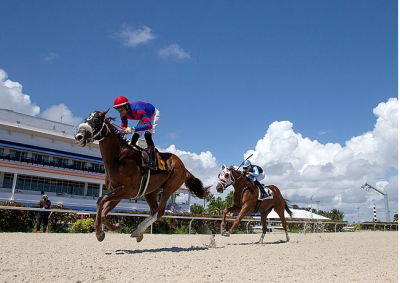By Noel Michaels
We’re two weeks into the long and stakes stacked Gulfstream Park Champions Meet, where the winter season that’s not so wintry in South Florida attracts most of the best trainers, jockeys, grass horses and graded stakes races through April 3.
All of which means this is a must-bet track for all serious horseplayers and handicappers over the next four months.
Gulfstream features several key 3-year-old prep races leading to the Florida Derby (G1) on April 2. The meet also features the $3 million Pegasus World Cup Invitational (G1) on a card loaded with stakes on Jan. 29.

Gulfstream Park – Photo courtesy of Joe DiOrio / BloodHorse
Gulfstream converted a portion of its turf course to a synthetic Tapeta track in 2021 and is currently racing as the first three-surface race track, with races being carded on the dirt main track, a Tapeta oval, and on the turf course. If rain forces races off the turf, Gulfstream plans to shift those races to the synthetic surface.
The Gulfstream meet customarily begins with horses shipping to Florida from all over the East and Midwest to join the cream of the local crop that has been competing at Gulfstream during the rest of the year.
Typically, shippers from Kentucky and New York often have a class edge versus the local horses, especially in allowances and optional claiming races. However, that’s no longer automatic since competitive horses at nearly all levels are being sent out by South Florida local trainers.
The December portion of the meet is akin to the old Tropical at Calder meet, which used to occupy the same timeframe. Later in December and into early January, however, is when the big guns from the top national stables begin arriving for their winter seasons. This means the Chad Browns, Todd Pletchers, etc. start filling the entries and dominating the tote board. This is a good opportunity for bargain-hunter handicappers, however, as many of these northern invaders show up in Florida needing a race and tend to do their best running once they’ve had a local outing under their belts. Well-bet invading December favorites have been known to go down in flames at low prices.
A premier jockey colony will be there as well except for Jose Ortiz, who is staying in New York. Also take note that Irad Ortiz, Jr. is currently serving a one-month suspension and will not return to ride at Gulfstream until early January.
With that, here’s some handicapping tips, angles, and winning trends based on the tracks’ prevailing biases and running style preferences over the past few years.
Preferred running styles at Gulfstream
The prevailing running style in dirt races tends to favor horses with early speed, or at least tactical speed, at all distances. Deep closers generally don’t do well on the main track, and inside posts and rail-skimming trips are usually not an advantage in one-turn races.
Gulfstream dirt sprints and miles tend to favor outside paths, while Gulfstream two-turn races favor inside posts and paths. Gulfstream’s one-turn one-mile races play much more like sprints than like other route races which are run around two turns (GP mile races play much closer to the track’s 7-furlong races than to GP’s 1 1/16-mile races). So, when handicapping at a mile, give an edge to milers, or horses stretching from 7 furlongs, as opposed to horses cutting back from 1 1/16 miles.
And your best post positions are …
In terms of favorable post positions, Gulfstream features differing preferences on the main track in both sprints and routes. Some of the prime golden rules at Gulfstream are to stay away from outside posts in main track two-turn routes – anything outside post 6 – and to stay away from far inside posts in dirt miles. Don’t bet the rail horse in any one-turn race at 6 1/2 furlongs or longer because that post shows sub-par win percentages and ROIs for the last decade.
Moving on to the grass races
Now let’s move to the grass, where a large part of the action takes place each winter at Gulfstream. Unlike on the dirt, a horse’s chances of success on the Gulfstream turf are based more on running style than post draw. More-so than any other racetrack, it seems to be most difficult to go wire-to-wire at Gulfstream in turf routes (including 7 ½-furlong races, which are statistically often lumped in with turf sprints, but play like routes, not sprints).
In turf sprints, speed plays totally the opposite. The 5-furlong Gulfstream turf sprints are dominated by speed horses, or at least horses that can stay within a length or two of the early lead. It is difficult for horses to have any success in these turf dashes from far off the pace or from the back half of the field. Even in turf sprints that are loaded with speed horses, you are better off betting “the speed of the speed” than you are looking for a closer. Generally, the off-the-pace types fall short. In terms of posts, the rail post 1 is not great at 5 furlongs on the turf, but the other inside posts 2-4, as well as pretty much any post position in the gate, are all OK.

Gulfstream Park new Tapeta surface – Photo courtesy of Coglianese Photos/Ryan Thompson / BloodHorse
A taste of Tapeta
The new Tapeta track has had a few months to break-in and mostly seems to be playing fair now after favoring closers a month or two ago. The best time to bet speed horses on the synthetic track is when it’s wet, because front-runners seem to do better in wet conditions.
Ready, set, win!
Have a great Gulfstream winter season. Put Gulfstream Park at or near the top of your wagering menu from now until the spring. You are bound to do well by following these simple tips and trends to help you win at the winter’s best race meet.

Noel Michaels has been involved in many aspects of thoroughbred racing for more than two decades, as a Breeders’ Cup-winning owner and as a writer, author, handicapper, editor, manager and promoter of the sport for a wide range of companies including Daily Racing Form and Nassau County Off-Track Betting.
He also is regarded as the leading source of news and information for handicapping tournaments and the author of the “Handicapping Contest Handbook: A Horseplayer’s Guide to Handicapping Tournaments”, which made his name virtually synonymous with the increasingly-popular tournament scene.
In addition to contributing to US Racing, he is also an analyst on the Arlington Park broadcast team.


